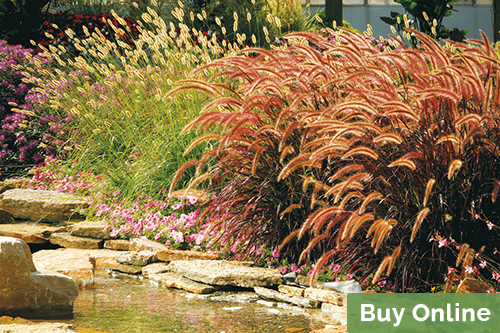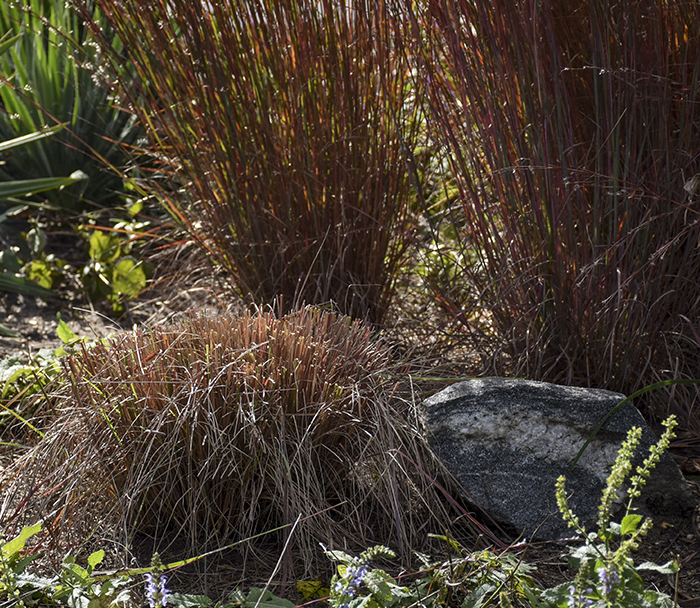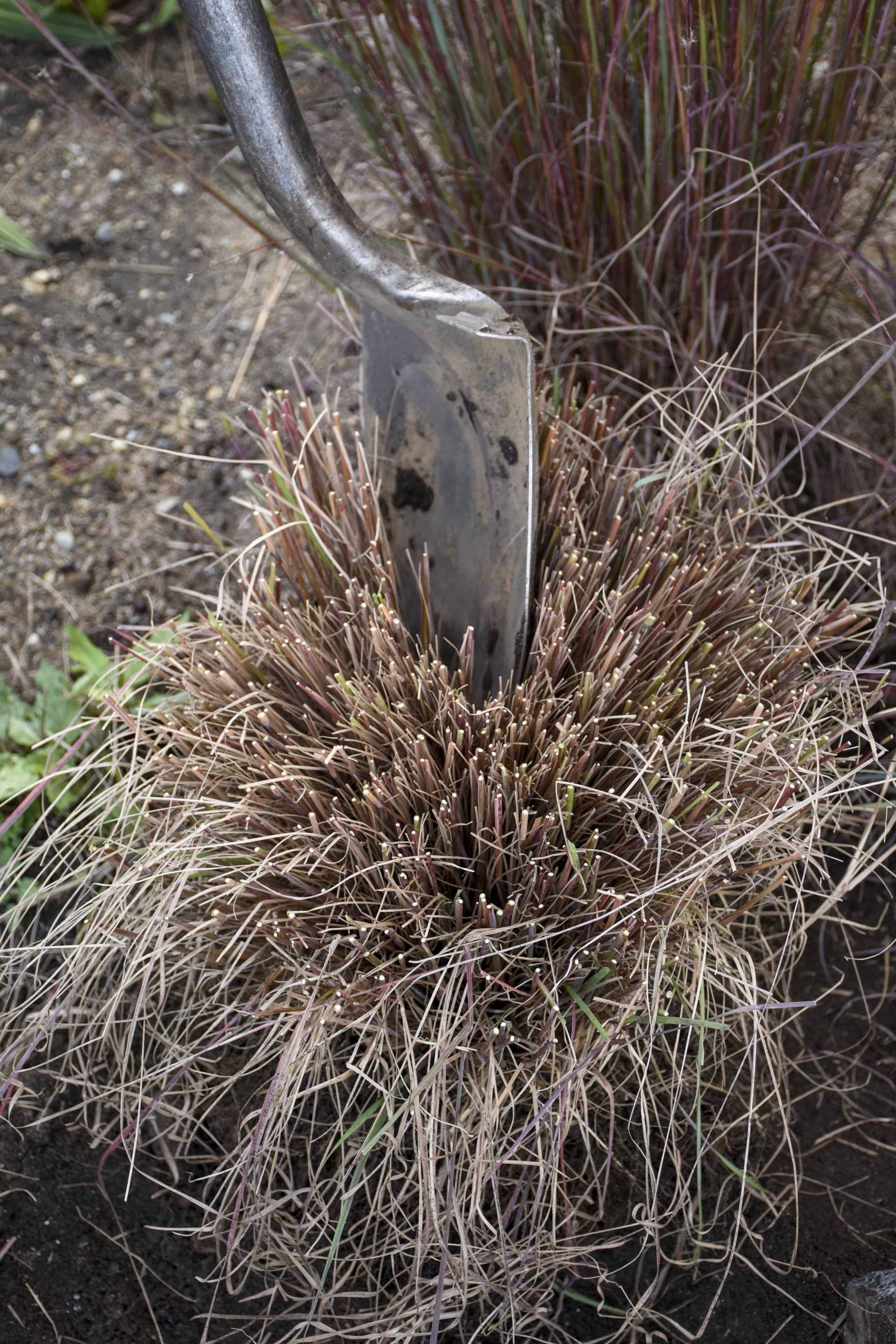How to Care for Ornamental Grasses
The most common questions we get about ornamental grasses care are when and how to plant, cut back and divide. Here are tips and techniques on how to maintain ornamental grass in your garden.
 Buy grasses online - Browse 14 types of grasses and have them shipped right to your door
Buy grasses online - Browse 14 types of grasses and have them shipped right to your door
In recent years interest and use of ornamental grasses has exploded. Ornamental grasses can fit into almost any garden theme. Ornamental grasses lend height, movement, and long season color to the landscape. Along with the proliferation of ornamental grasses have come a host of questions on how to care for them properly. Our most common questions are:
- When to plant ornamental grasses?
- Do I need to trim my grass back and if so when?
- How and when should I divide my ornamental grass?
We will give you some general rules to follow when planting, cutting back, and dividing ornamental grasses.
Grasses are generally classified as cool season, warm season, or evergreen. The rules change just slightly depending on which type of grass you have.
- Cool-season grasses put on most of their growth in spring before temperatures begin exceeding 75 degrees Fahrenheit and in the fall when temperatures cool down. They generally maintain good color through the summer but won't grow much when it is hot.
- Warm-season grasses won't start growing until mid to late spring or even early summer. Their major growth and flowering happens when the weather is hot. They will usually turn shades of brown for the winter. Think fountain grass.
- Evergreen grasses are usually plants that look like grasses but aren't actually classified as grasses. Plants like the sedges and carex are grass-like but not grasses.
WHEN TO PLANT ORNAMENTAL GRASSES
The best time to plant new ornamental grasses in your landscape is spring or early fall. Planting before the summer’s heat (and often dry weather) arrives should give them enough time to root in before having to endure more stressful conditions. It can be tough to keep them watered well enough if planted in summer, so if you miss the spring window, aim to plant in early fall at least 6-8 weeks before the first frost.
Related: What to Plant with Ornamental Grasses
WHEN TO CUT BACK ORNAMENTAL GRASSES
Cut back warm-season grasses in fall or by mid to late spring.
Warm-season grasses turn shades of brown as the weather turns colder. Once your warm-season grasses turn brown you can trim them back at almost any time. If you like to tidy your garden in fall or if you live in an area where fire can be problematic trim warm-season grasses so they are just a few inches tall. If you live in an area where fire generally isn't a problem you can leave the dried grasses and seed heads in your garden for winter interest. Snow or ice encrusted ornamental grasses can be quite beautiful. If you leave the trimming until spring try to make sure to cut them back to the ground (you can leave a couple of inches) by late spring, before new growth begins. Not all ornamental grasses look good through the winter, trim back those that don't look good in the fall.
Cut back cool-season grasses in very early spring.
Cool-season grasses tend to look good even as the weather cools. Leave their foliage in place until spring and then as soon as the snow is gone cut them back. Leave about 1/3 of the plant in place. Trimming cool-season grasses too harshly can irreparably harm the plant.
 HOW TO TRIM ORNAMENTAL GRASS
HOW TO TRIM ORNAMENTAL GRASS
First, find a good pair of gloves, thick leather gloves are probably best. Some ornamental grasses can have very sharp edges. For smaller grasses a pair of pruning shears will probably be sufficient. Trim about 2/3 of the plant for cool-season grasses. For many grasses it is easier to tie the grass in a bundle before trimming, this makes clean up a snap. For short grasses this might not be possible.
If you have a large, established clump of grass, you may need to use a weed eater (with a blade rather than string), electric or gas powered hedge trimmers, or even a chain saw. Once again, tie the tops together for easier clean up, just toss the bundles into your compost pile. If you have only one of these large grasses you can cut them back with pruning shears but it isn't easy. I know. I've done it!
WHEN TO DIVIDE ORNAMENTAL GRASSES
Dividing grasses is one way to increase the number of plants without spending additional money. Occasional division will help grasses remain active and growing and can help renew older grasses. Some grasses, over time, will die out in the center and dividing will rejuvenate the clump.
Divide warm season grasses anytime spring through mid-summer.
All ornamental grasses should be divided when they are actively growing but not while they are flowering. If the plants are dormant when they are transplanted they won't establish a good root system. Warm-season grasses generally start growing in late spring or early summer and have their active growth period during the heat of the summer. Warm-season grasses will tend to bloom in mid to late summer.
Divide cool-season grasses in spring or early fall.
Cool-season grasses are actively growing in spring and fall. These grasses can be transplanted at either time of the year but early spring is probably the best time to divide. If you do divide them in the fall, be careful that the freeze/thaw cycles of winter don't heave the plants out of the ground, this happened to a couple of my coral bells last winter.
Divide evergreen grasses and grass-like plants in spring only
Evergreen grasses don't ever go dormant. Dividing plants wounds them to some degree. For evergreen grasses this wounding will really affect their ability to live through the winter.
 HOW TO DIVIDE ORNAMENTAL GRASSES
HOW TO DIVIDE ORNAMENTAL GRASSES
For smaller grasses it is very similar to dividing a perennial:
- Dig up the grass and use your hands, pruning shears, a knife, or a sharp shovel or trowel to cut or pull the clump into several pieces.
- Make sure that each piece has some healthy roots.
- Replant them before the roots dry out, you may need to cover the exposed roots to protect them on sunny days.
Just a reminder that grass leaves can be very sharp, wear gloves to protect your hands. I can tell you from personal experience grass cuts can really hurt.
Larger grasses use the same basic principles but due to sheer size and toughness can be harder to deal with. It can take a strong back, or three, to get some of these very large grasses out of the ground. Dig and/or pry the clump out of the ground (don't be afraid of using a crow or pry bar) and then divide it into pieces, making sure each piece has some roots.
An old hand or hack saw, an axe or hatchet (it may be easier to place the axe blade in one spot and then pound it through the grass clump using a large hammer or maul, I know I can never hit the same spot twice when swinging an axe), a very sharp shovel, a reciprocating or concrete saw, or a chain saw (this won't be gentle on your grass and will tear it up a bit, a chain saw should be your last resort) can all be used to divide the plant into pieces. These big grasses are quite tough.
An alternate method would be to cut the grass to the ground then use an axe or other tool to cut it into wedges. Pry or dig the pieces out of the ground. Once these larger pieces are removed from the ground you can cut them into smaller pieces using sharp pruning shears.
If your main clump is still looking quite healthy and hasn't outgrown its space, you can replicate the plant by removing small chunks of the grass from around the outer edge. This may be easier than dividing the entire plant.
Once you have the pieces removed from the main clump, trim off any dead material, replant the pieces, and water thoroughly. Newly divided grasses will need frequent watering while they become established. Once they are well rooted you should be able to decrease or quit watering.
DO ORNAMENTAL GRASSES NEED TO BE FED?
Many ornamental grasses are selections of native prairie or woodland plants. In their natural habitat, the only nutrients they receive comes from their own decomposing foliage and that of the plants around them. You can mimic those conditions by mulching around the base of your grasses in fall with shredded leaves. No other fertilizer is needed or desired by grasses; in fact, feeding them often causes them to stretch and flop over.
ARE ORNAMENTAL GRASSES DROUGHT TOLERANT?
It depends on the type of grass. To know if the one you’re growing is drought tolerant, you first need to identify what kind of grass it is.
- Native prairie grasses like Panicum and Schizachyrium are quite drought tolerant and in most cases, can easily survive without much supplemental water.
- Annual and perennial types of Pennisetum are not drought tolerant. They do not like the soil to dry out, but don’t like soggy wet soil either. Aim to provide average moisture, meaning not too wet and not too dry. You’ll know the soil is too dry if the tips of the leaves turn brown. While that won’t be as noticeable on green-leaved varieties, it will be very obvious on those with dark purple or red foliage.
- Some grasslike plants like Cyperus and Scirpus are water lovers—in fact, they can even grow in standing water. They can handle average moisture in garden beds and containers, but they will really put on a show if you give them a drink frequently.



 HOW TO TRIM ORNAMENTAL GRASS
HOW TO TRIM ORNAMENTAL GRASS HOW TO DIVIDE ORNAMENTAL GRASSES
HOW TO DIVIDE ORNAMENTAL GRASSES

